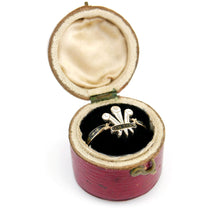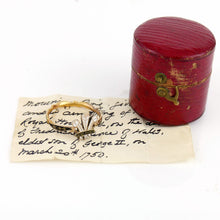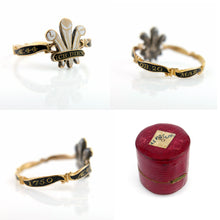Frederick, Prince of Wales Mourning Ring, 1751
SOLD
Tax included.
Adding product to your cart
21mm x 19mm x 11mm
Gold and enamels. The Prince of Wales’s feathers and motto ‘Ich Dien’ (I Serve) in silver overlaid with gold and set with enamels, the band formed of five gold scrolls set with black enamel inscribed ‘F:P:W: / OB:20/MAR / 1750 / Æ:44’ for Frederick, Prince of Wales, died 20 March 1750 [Julian calendar], aged 44. Contained in its original eighteenth century silk-lined red leather case with manuscript note of provenance, viz - ‘Mourning ring, given to Andrew Armstrong of the Royal Household, on the death of Frederick, Prince of Wales, eldest son of George II, on March 20th 1750’; the bottom of the case bearing old label inscribed in ink with number ‘8’ and ‘Armstrong’.
Frederick, Prince of Wales, K.G., (1707-1751), was the estranged son of George II and Caroline of Ansbach. He died unexpectedly and intestate in his forty-fourth year after catching a cold while out in the rain. Born and left behind in Hanover (as a representative of continued authority) when his father and the rest of the Royal Family moved to England in 1714. Frederick arrived in England over a decade later as a virtual stranger to his parents. Moreover Frederick was a high-spirited youth fond of drinking, gambling and women. Increasingly he opposed them in everything he did. He sponsored a court of 'opposition' politicians and with his supporters patronised an opera company in direct competition with Handel’s Royal Opera company at the King’s Theatre.
Arrangements for the funeral of Prince Frederick in 1750 are said to have been marred by George II’s noted favouritism towards his younger son William, Duke of Cumberland, torrential rain on the day of the funeral service and the absence of a will. The widowed and debt ridden Princess of Wales was anxious not to antagonise her parents-in-law and thereby risk losing influence over her son, Prince George, the future George III (reigned 1760-1820). Accordingly it was left to Sir Thomas Bootle (1685-1753) as chancellor of Prince Frederick's household to organise the mourning ritual and distribution of mourning rings.
Mourned by his friends as the greatest King England never had, Frederick took his dynastic responsibilities seriously and despite his failure to make a will, penned ‘Instructions for my Son George’, which includes advice on a range of subjects from war and the national debt, Hanover, and personal and kingly conduct. Written in 1749 , the ‘Instructions’ to the future King George III, included the premonitory line - ‘I shall have no regret never to have wore the Crown, if you do but fill it worthily’.
Use left/right arrows to navigate the slideshow or swipe left/right if using a mobile device






